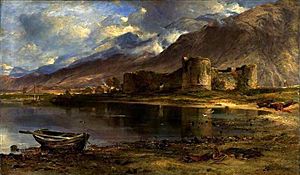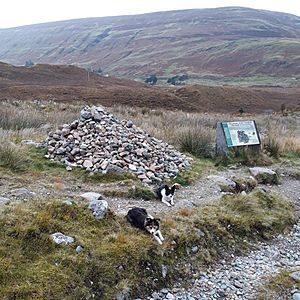Battle of Inverlochy (1645) facts for kids
Quick facts for kids Battle of Inverlochy |
|||||||
|---|---|---|---|---|---|---|---|
| Part of the Wars of the Three Kingdoms | |||||||
 Inverlochy Castle Ben Nevis in the background |
|||||||
|
|||||||
| Belligerents | |||||||
| Commanders and leaders | |||||||
| Lord Montrose Alasdair Mac Colla Sir Thomas Ogilvie † |
Sir Duncan Campbell of Auchinbreck † | ||||||
| Strength | |||||||
| 1,500 | 2,000-3,500 | ||||||
| Casualties and losses | |||||||
| Few | 1,500 | ||||||
| Official name | Battle of Inverlochy II | ||||||
| Designated | 30 November 2011 | ||||||
| Reference no. | BTL24 | ||||||
The Battle of Inverlochy happened on 2 February 1645. It was part of the Wars of the Three Kingdoms, a series of conflicts across Britain and Ireland. In this battle, a Royalist army, made up of Scottish Highlanders and Irish soldiers, completely defeated the Covenanter forces.
The Royalist army was led by James Graham, 1st Marquess of Montrose. The Covenanter army was led by Archibald Campbell, 1st Marquess of Argyll. The fight took place near Inverlochy Castle. This area was officially named a battlefield by Historic Scotland in 2011.
Contents
Why Did the Battle of Inverlochy Happen?
Scotland's Role in the English Civil War
During the 1640s, Britain was in a big conflict called the Wars of the Three Kingdoms. This included the English Civil War. In England, King Charles I (the Royalists) was fighting against Parliament (the Parliamentarians).
Scotland also had its own civil war. The Scottish Parliament, controlled by a group called the Covenanters, decided to support the English Parliament. They sent their armies to help fight King Charles I.
Montrose's Royalist Uprising
King Charles I wanted to stop the Scottish Covenanters from helping his enemies in England. So, he asked James Graham, 1st Marquess of Montrose to lead a Royalist uprising in Scotland. Montrose had once supported the Covenanters but now sided with the King.
To help Montrose, Confederate Ireland sent about 2,000 experienced soldiers to Scotland. These Irish troops landed in July 1644. They were led by Alasdair Mac Colla.
Montrose's Early Victories
Montrose and his small group of Royalist clansmen joined forces with Mac Colla in August. The Covenanters sent armies to stop them. But Montrose won surprising victories at Tippermuir and Aberdeen in September.
After these wins, Montrose moved into the Highlands. He was chased by a Covenanter force led by the Archibald Campbell, 1st Marquess of Argyll. Argyll was the leader of Clan Campbell and a key Covenanter figure.
Winter Campaign and Montrose's Trap
By late November, Montrose's army grew to about 1,000 more soldiers, mostly from Clan Donald. Over the winter, they attacked and burned lands belonging to Argyll himself. This included the town of Inveraray.
Montrose left Inveraray in January 1645 and headed north. The Covenanter leaders, Baillie and Argyll, thought Montrose's army would get stuck in the Highlands during winter. They believed his supplies would run out and his soldiers would leave.
By the end of January, Montrose's army was indeed struggling. They were at Kilchummin in the Great Glen. Supplies were low, and many soldiers had left. Montrose learned that a large Covenanter force blocked his way north at Inverness. Another Covenanter army, led by Argyll, was camped south of him at Inverlochy. Montrose's army was now trapped.
The Amazing Flank March
Montrose's Bold Decision
Montrose decided to attack Argyll's army to break free. He knew a direct attack would be easily seen. So, he chose a very risky plan: a surprise march around Argyll's forces.
A Difficult Journey
This march happened in winter, across some of the toughest land in Britain. The soldiers had to walk through knee-deep snow. They traveled up the River Tarff and over high ground. They climbed 1,000 feet to Carn na Larach. Then they went down through Glen Turret and Glen Roy.
After crossing the Spean and going through Leanachan Woods, they reached the slopes of Ben Nevis. They arrived near Inverlochy in the early hours of 2 February. They had marched about 36 miles in just 36 hours!
The Battle of Inverlochy
A Cold Night and a Big Surprise
Montrose's army spent a cold night on the side of Ben Nevis. Argyll knew a small force was nearby, but he didn't know Montrose's entire army was there. Just before dawn on 2 February 1645, Argyll and his officers were shocked. Montrose was supposed to be 30 miles north!
Who Fought Where?
- Royalist Army (led by James Graham, 1st Marquess of Montrose):
- Irish Brigade (about 800 soldiers)
- Highlanders from Clan Donald, Clan Cameron, and other clans (about 500 soldiers)
- Other Scottish Royalists (about 200 soldiers)
- A small group of cavalry (50 horsemen)
- Covenanter Army (led by Sir Duncan Campbell of Auchinbreck):
- Marquess of Argyll's own soldiers (500 men)
- Clan Campbell soldiers (about 1,000 men)
- Other Covenanter soldiers (about 400 men)
Argyll himself did not stay for the battle. He had hurt his arm and went to his ship on Loch Linnhe. Command of the Covenanter forces went to his relative, Sir Duncan Campbell of Auchinbreck. Auchinbreck was an experienced soldier.
The Battle Begins
Auchinbreck placed his forces with one side near Inverlochy Castle. He put 200 musketeers (soldiers with muskets) in the castle to protect his flank. In the middle were Argyll's soldiers. On the sides were Lowland militia. Unlike Montrose's earlier battles, many of these Covenanter troops were experienced fighters.
Montrose arranged his army in two lines. He put the Highlanders in the middle and the Irish soldiers on the sides. A small group of cavalry protected the Royalist flag.
The fight didn't start right away. There were small skirmishes before dawn. Montrose wanted to keep Argyll's men busy and hide the full size of his army. The Covenanter officers thought they were only fighting a small part of Montrose's army. They only realized Montrose was there when they heard his trumpets signal the attack.
The Royalist Attack
Just before dawn, the Royalists launched their main attack. The Irish soldiers charged first. They quickly fought hand-to-hand with the Covenanter troops on both sides. The Irish routed (completely defeated) the Covenanter wings. This left Auchinbreck's center exposed.
Montrose then sent his Highlanders to attack Argyll's soldiers and the Campbell clansmen. The first line of Covenanters was pushed back. The second line panicked and broke. Some of the Covenanter soldiers tried to run into the castle, but Montrose's cavalry blocked them. They were pushed towards the loch.
Auchinbreck was shot in the leg while trying to rally his men and died soon after. The remaining Covenanters briefly tried to fight, then broke and ran. The battle quickly turned into a chase and a "massacre" as one clan fought another. Those who ran towards the loch were killed. Others tried to escape into the hills. The small group of soldiers in Inverlochy Castle surrendered without a fight.
Casualties
Most deaths in battles back then happened when soldiers ran away. The Royalists chased the Covenanters for at least eight miles. Over 1,500 Covenanter soldiers died. Montrose lost very few men, perhaps only four to eight. The most important Royalist who died was Sir Thomas Ogilvie, who was hit by a stray bullet. Many important Covenanter leaders were also killed.
A poet named Iain Lom from the Clan MacDonald watched the battle. He later wrote a poem about it called "Là Inbhir Lochaidh" ("The Day of Inverlochy").
What Happened After the Battle?
Montrose's Treason and Argyll's Response
On 11 February, the Scottish Parliament declared Montrose and 19 of his followers guilty of treason. The next day, Argyll appeared before Parliament with his arm in a sling. He tried to play down the defeat, calling it a small setback.
Clan Rivalry
Montrose used this victory to unite Clan Donald against Clan Campbell. The Battle of Inverlochy was not just part of the civil war. It was also a big part of the long-standing feud between these two powerful clans. This is how the battle is remembered in Scottish stories.
After the battle, the MacDonalds chased the fleeing Campbells up the Lairig Mhor. This path is now part of the West Highland Way. They killed those they caught. About 12 kilometers from the battlefield, they stopped. They marked the spot with a stone, which became known as Clach nan Caimbeulach, or the Campbell's Stone. Today, a rough pile of stones marks the place.
Impact on the Royalist Campaign
The victory also helped Montrose get support from the Marquess of Huntly. Huntly's Clan Gordon soldiers made him one of the most powerful nobles in Scotland.
The battle and Montrose's campaign are featured in the 1937 novel And No Quarter by Irish writer Maurice Walsh. The story is told from the viewpoint of two soldiers from O'Cahan's Regiment.


